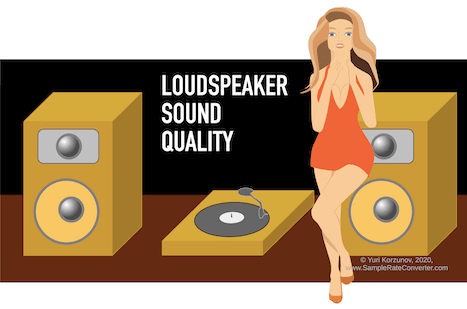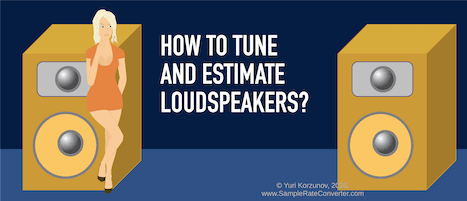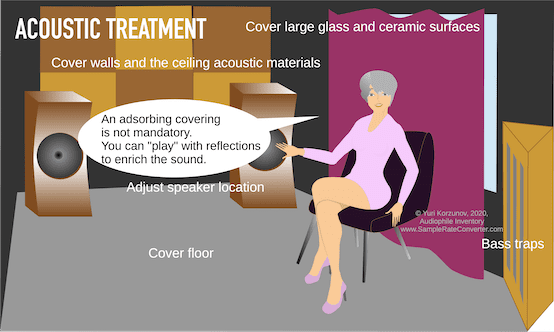
Do you love listening to music? If so, you probably care about the quality of the sound you hear. But do you know how loudspeakers work and how they affect your listening experience? In this article, you’ll learn everything you need to know about loudspeakers, from their types and functions to their physics and performance. You’ll also discover how to choose the best loudspeakers for your audio system, how to tune your acoustic environment, and how to deal with common issues and questions. Whether you’re a casual listener or an audiophile, this article will help you get the most out of your loudspeakers and enjoy your sound like never before. Ready to dive in? Let’s get started!

If you buy "AuI ConverteR PROduce-RD" (2023/12.x version) from 24 August 2023 to 24 October 2023, you will get free update to version 2024 (13.x) after its release.
- Overview
- What is a loudspeaker?
- Who invented a loudspeaker?
- What are the types of loudspeakers?
- What is twitter?
- What is woofer?
- Why subwoofer is needed?
- Is a difference between speakers there?
- How much does a loudspeaker cost?
- How does a loudspeaker works [physics]?
- Loudspeaker sound quality
- Acoustic system tuning
- Speaker cables
- Conclusions
- Frequently asked questions

Overview
Loudspeakers affect sound quality a lot. But numbers and graphs don’t tell you everything. Many things change how you hear sound. They are hard to measure and understand. So your hearing is the best judge of sound quality.
How can you improve your hearing and loudspeakers? This article will teach you how loudspeakers work. You will learn how they work with your space and brain. You will also learn how to pick the right loudspeakers, tune your space, and solve common problems. This article will make you enjoy your sound more. Are you ready? Let’s begin!
Back to topWhat is a loudspeaker?
We can meet "speakers" and "loudspeakers" terms. Both ones mean the same.
A loudspeaker is a converter of electric oscillation (of voltage or current) to acoustic waves. How it works read below.
Speakers are divided into different types: by destination, by placement, by type of driver. Read more below.
Back to topWho invented a loudspeaker?
| 1861 | Johann Philipp Reis applied a telephone electric loudspeaker to reproduce tones and low-quality speech |
| 1876 | Alexander Graham Bell patented loudspeaker (as part of its telephone), that capable to reproduce clearer speech |
| 1878 | Ernst Siemens improved the loudspeaker |
| 1898 | Horace Short patented a compressed-air-driven loudspeaker |
| 1898 | Oliver Lodge established the modern design of dynamic loudspeakers (moving-coil driver) |
| 1915 | Peter Laurits Jensen and Edwin Pridham applied dynamic loudspeakers (moving-coil driver) |
| 1924 | Chester Williams Rice and Edward Washburn Kellogg patented moving-coil technology that is commonly used now |
What are the types of loudspeakers?
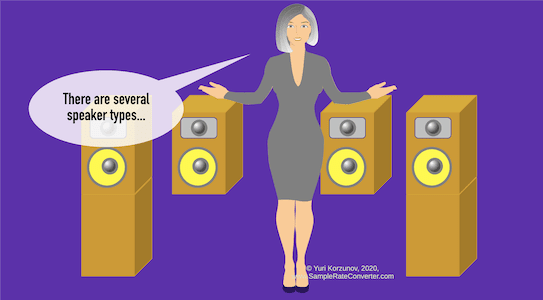
Destination speaker types
- home speakers;
- stereo speakers;
- front speakers;
- surround/rear speakers;
- subwoofers;
- surround system;
- studio monitors;
- concert speakers;
- cinema speakers;
- Bluetooth/Wi-Fi/wireless speakers;
- others.
| Type | Description |
|---|---|
| Home speakers | Home speakers are intended to use at home. This type of speaker is a leader in sound quality, in general case. |
| Stereo speakers | Stereo speakers is any speakers. Mandatory requirement: it is 2 identical speakers. Ideally, they should be absolutely the same by measured parameters. |
| Front speakers | Front speakers are the same stereo speakers, that are included in a surround system and placed before a listener. As rule, these speakers should have the best sound quality in the system. |
| Surround/rear speakers | Surround/rear speakers are included in a surround system. And they may have quality worse than front ones. But for modern systems and recordings, it is recommended, that all speakers of a surround system are the same. |
| Subwoofers | It is an additional speaker, that is used to expand a low-frequency range of front or stereo speakers. Read more... |
| Surround system | As rule, it is a surround system in low-budget (5.1 loudspeaker kit). Also, hi-fi/hi-end vendors provide a family of high-quality speakers, including front, surround, subwoofer units. |
| Studio monitors | It's designed to produce music. Sound quality is desired but is not mandatory. The main requirement is reproducing of tiniest sonic details in the audible frequency range. Because a sound engineer should listen to all nuances. There should not be hidden sounds. If the frequency or harmonic distortions are there, the engineer can adjust it to a target system (hi-fi, radio, car, boombox, etc.) anyway. |
| Concert speakers | The main requirement is a pushing capability of significant air mass in big rooms and open air. Also, concert monitors for musicians at a scene are included in this loudspeaker type. This type of speakers may sound worse, comparing audiophile home loudspeakers. |
| Cinema speakers | They rather are designed for big multichannel systems and reproducing cinema sound effects. |
| Bluetooth/wi-fi/wireless speakers | They are designed for easy wireless connection with musical systems. |
Placement types
Home audio speakers have the main types of placement:
- bookshelf;
- to fix at the ceiling or wall;
- on-floor;
- built-in walls, ceiling;
- at/into elements of building exterior or landscape;
- others.
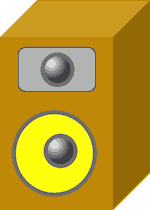

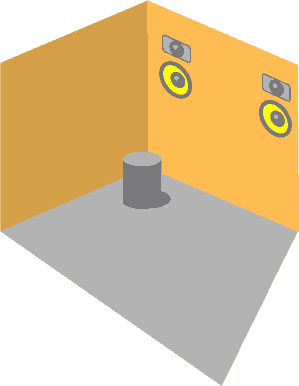
As rule, built-in speakers are used for interior and landscape design. Its placement is a matter of sound quality.
Bookshelf loudspeakers allow to placing them on walls or shelves, if no available place on the floor or by interior design issues.
Commonly, the author recommends on-floor speakers due to larger enclosure volume (especially, in a big room). But it can't guarantee better sound quality than the aforesaid types.
Back to topSignal feed types
There are 2 signal feed types:
- active;
- passive.
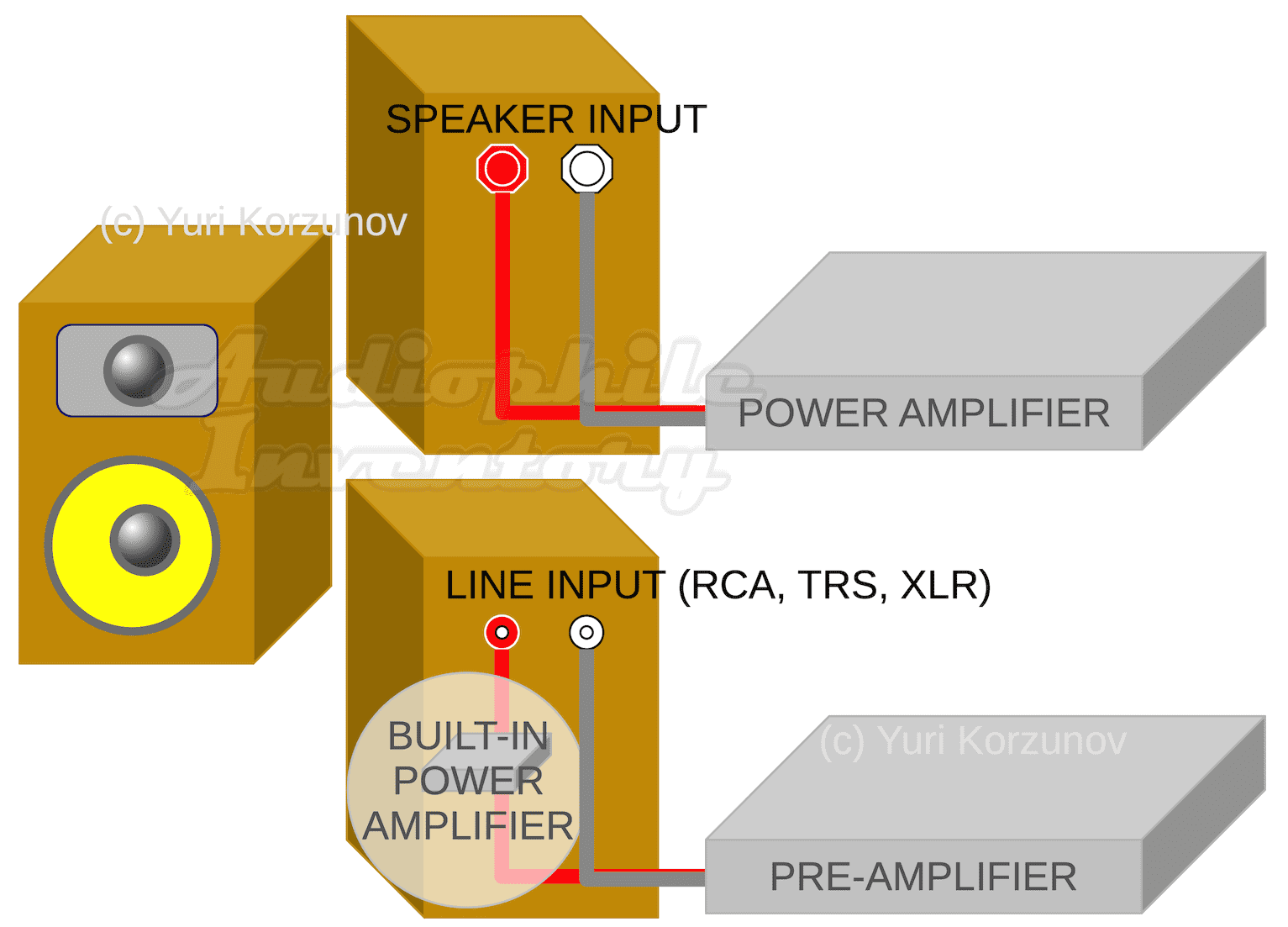
As rule, hi-fi speakers have not built-in amplifiers and contains passive filters only.
Theoretically, built-in amplifiers may be better electrically adjusted to speaker drivers, including active and digital, crossovers. But the author recommends to check actual sound out.
The line input is low voltage input (0.3 ... 2 V) to connect pre-amplifier, mixer, tape, phono preamp, etc.
Also, subwoofers may have both input types: linear and speaker.
Back to topDriver type by the principle of action
There are driver popular types by the principle of action:
- voice coil (electromagnetic coil);
- electrostatic;
- piezoelectric;
- thin-film.
Voice coil (electromagnetic coil) drivers
Voice-coil drivers are the most popular and work on the principle of mechanical force between the magnet and the magnetic field of electrical current.
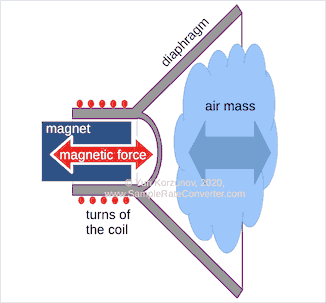
Current passes through the coil wires and creates the magnetic field. It interacts with the magnet and the diaphragm moves.
Electrostatic drivers
Electrostatic drivers move sound-radiating diaphragm between stators. The diaphragm is charged and to be attracted to one of the stators due to electrostatic force.
Electrostatic drivers try to solve some mechanical issues of voice-coil ones. But electrostatic drivers have own issues.
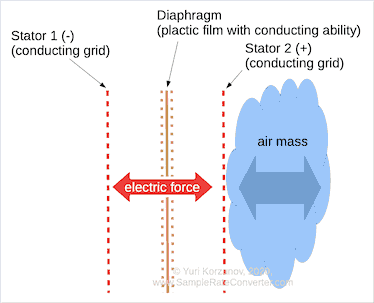
AC sound voltage feed stators, that charge the diaphragm. And electrostatic field moves the charged diaphragm in direction to the oppositely charged stator.
Piezoelectric drivers
Piezoelectric drivers are primarily used in electronic devices and sonar applications. The drivers are based on the effect of mechanical deformation of piezoelectric material under the electric field.
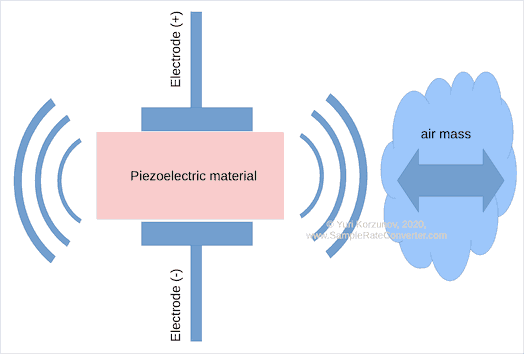
Electric tension between the electrodes deforms the piezoelectric material. It moves the air mass.
Thin-film drivers
Thin-film drivers are new type of loudspeaker drivers that can turn a surface into an acoustic wave source. Its authors promise high sound quality and low consuming of power energy.
The design of the driver type is relied on tiny domes on a thin layer of piezoelectric material. The domes can vibrate individually.[*]
Back to top
Driver type by frequency range
There are loudspeaker driver types:
- Low-frequency driver (woofer, subwoofer);
- Mid-range driver;
- High-range driver (twitter);
- Wide-range driver (full-range drivers).
The frequency ranges are not standard.
As example, a subwoofer is designed to produce a frequency range of about 20 ... 120 Hz.
And "full-range" driver cover not full audible range 20 ... 20 000 Hz, but so wide range as it can.
The frequency range is defined by frequency range, where the maximal deviation of the sound pressure level is lesser than the defined value.
These types have a different construction. Read details...
Back to topWhat is twitter?
A "twitter" is a speaker or its driver that radiate high frequencies (high notes).
It has special small-size construction. Also, twitter may have a hard diaphragm surface. It reduces effect of multiple sound-wave sources that placed on the diaphragm surface.
Back to topWhat is woofer?
Woofer is a speaker or its driver that producing low frequencies.
Back to top
Why subwoofer is needed?
A subwoofer is a dedicated loudspeaker to reproduce the lowest frequencies (lowest notes).
It is most popular in home theater setups.
There are discussions: is subwoofer needed for music or not?
Subwoofer destination is slightly various for cinema and music applications. In cinema applications, subwoofers may be used primarily to bring sensation.
Music system users are more particular about minimization of distortions.
It needs to remember, that music stuff contains low frequencies. And an acoustic system, that capable of playback in this frequency range, will reproduce more details of a musical recording.
However, to achieve a proper result, a subwoofer should be adjusted correctly and have a low distortions level.
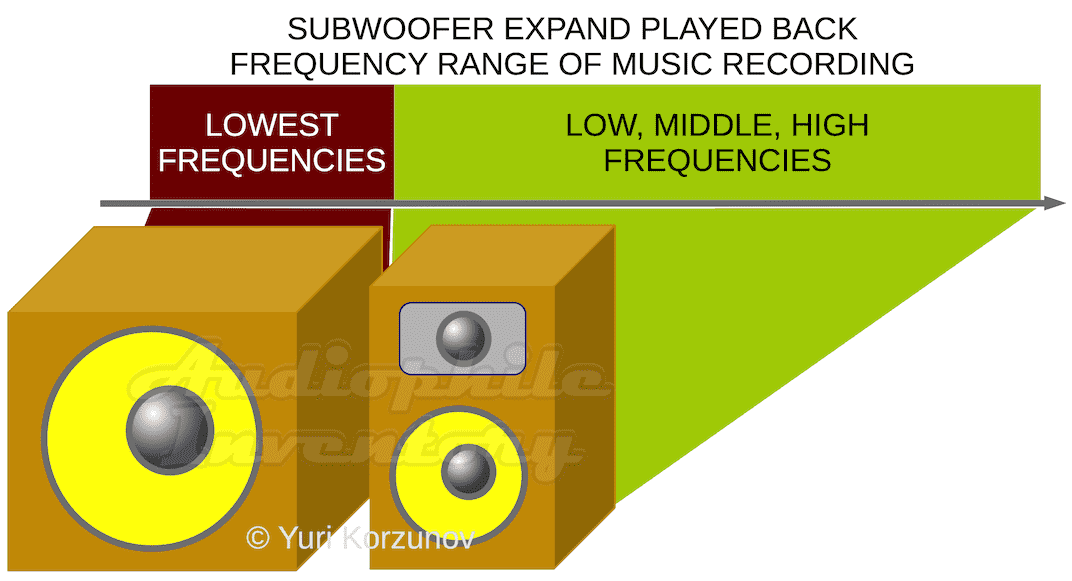
How to check phase alignment between subwoofer and loudspeakers
Back to topIs a difference between speakers there?
A loudspeaker with a room is an integrated system. You can't "listen to speakers". You can listen to the system:
- listening room;
- speakers;
- amplifiers;
- (sometimes) cables;
- other equipment.
The quality of a speaker depends on the quality of the loudspeaker's drivers.
Its specification includes apart from magnitude-frequency and phase responses also harmonic distortions (that simplistic presented by THD - total harmonic distortions).
In a system with other components, the speakers may sound better or worse.
There are ways to adjust the listening room mechanically and magnitude-frequency and phase responses electrically. But these ways are not ideal and harmonic distortions, practically, may not be removed.
The drivers work together with the enclosure. So, some issues of constructions may not be compensated.
Back to topHow much does a loudspeaker cost?
DISCLAIMER: There are no strict rules, of course. In different countries the ranges of prices are different. But we'll try to find some trend.
Speaker sound may be corrected via adjusting of room, magnitude-frequency and phase responses via an equalizer or an EQ software (room correction software). But we can't correct these characteristics exactly.
Also, we must remember: these characteristics are various at different locations of a listening room.
We can't affect harmonic distortions and the push-air capacity of a speaker. The room can't solve the harmonic-distortion issue of a speaker.
Back to top
What difference between stereo loudspeaker systems for $100 and $500-$2000?
Fidelity of playing. When a speaker is more expensive, more sound "transparency" is expected.
For prices more than $500-$1500, the increment of quality is lesser than below $500.
What difference between stereo loudspeaker systems for $500 and $3000?
Higher playing fidelity of low and very low levels of loudness is expected.
Design and expensive materials are matter too.
How does a loudspeaker works [physics]?
Loudspeaker contains:
- driver;
- enclosure with a system of acoustic wave channels;
- crossover.
The driver has the diaphragm, that works as a plunger, pushing air mass.
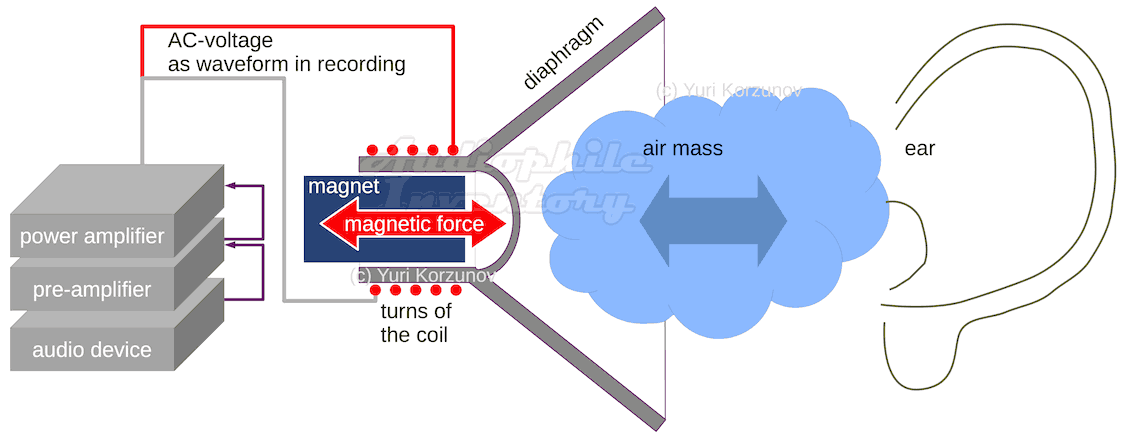
The diaphragm is moved via magnetic force.
The force is created by the interaction of the magnetic field from the electromagnetic coil and the magnet.
Coil's magnetic field appears due to electric current, passing through the turns.
The current is managed by the voltage from the power amplifier.
Back-to-front cancelation
The rear side of the diaphragm push air behind the driver (rear air). Acoustic wavelength is commensurate with diaphragm size. And the wave goes around the diaphragm. It's called "diffraction".
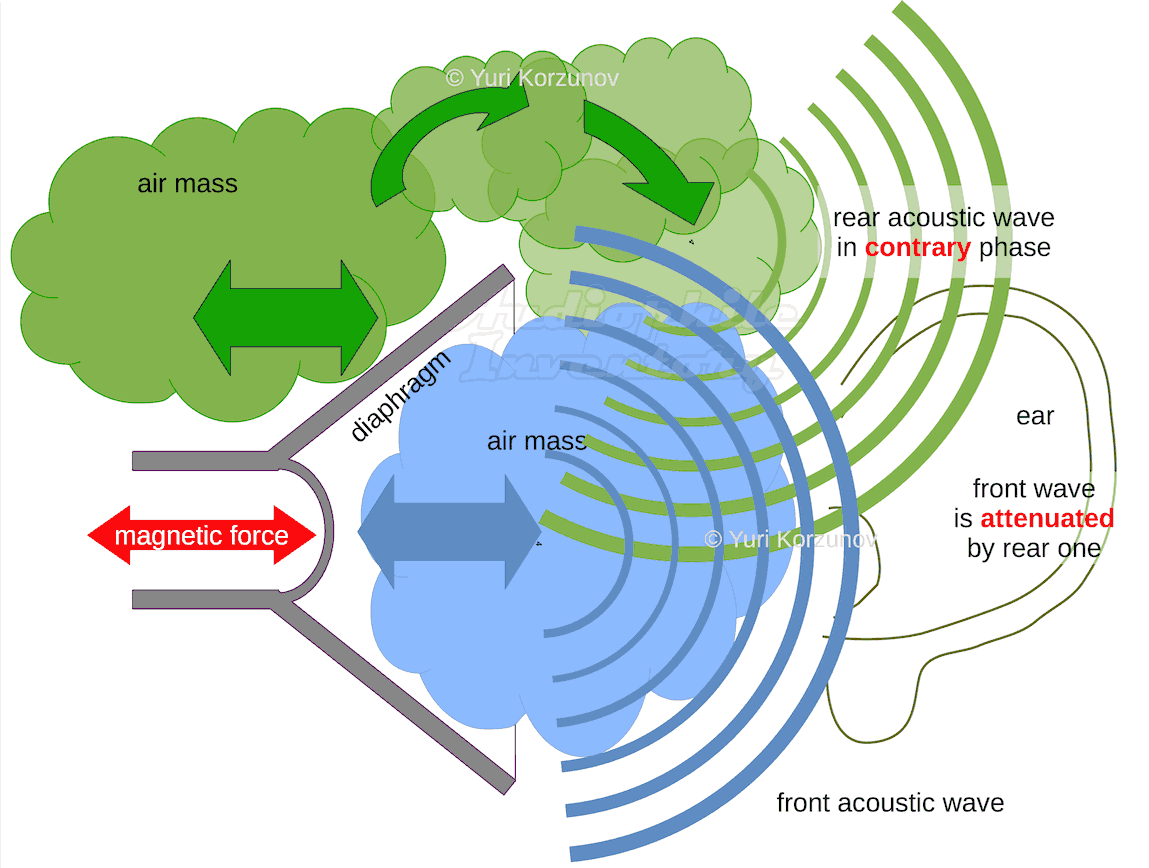
So rear and front acoustic waves interfere (are summarized). Put simply, these waves oscillate in the contrary phase. Air pressure (of both waves) alters in different directions. And pressure on the ear from the front wave is attenuated by the rear wave.
Speaker spread acoustic waves in all directions (wave rays). These waves bounced and re-bounced from all surfaces on their path.
These rays interfere (summarize) in each location of a listening room individually. It's impossible to get identical wave interference at all points of the room.
To avoid or reduce the cancellation:
- rear wave may be isolated by closure (closed-box loudspeakers); or
- the diaphragm should be significantly more wavelength; or
- rear wave phase should be inverted (reflex port).
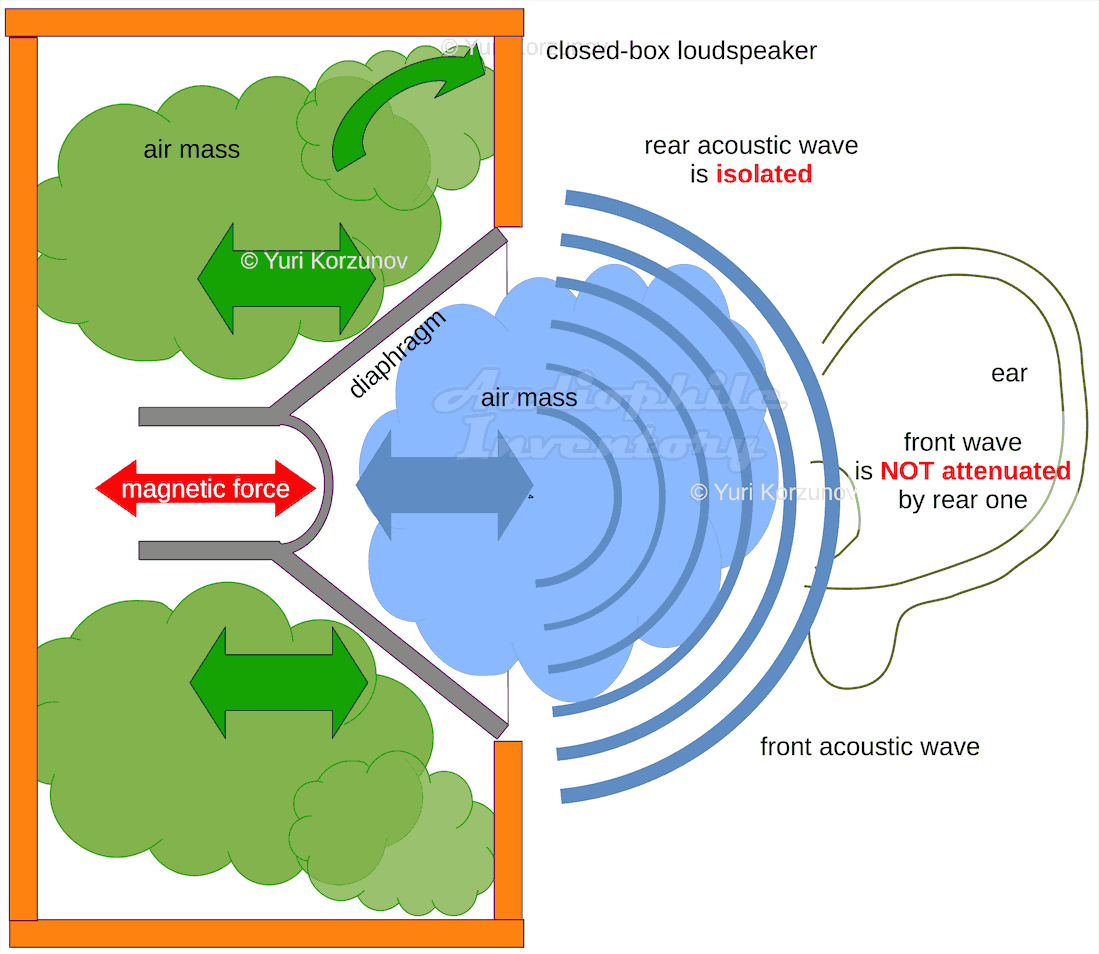
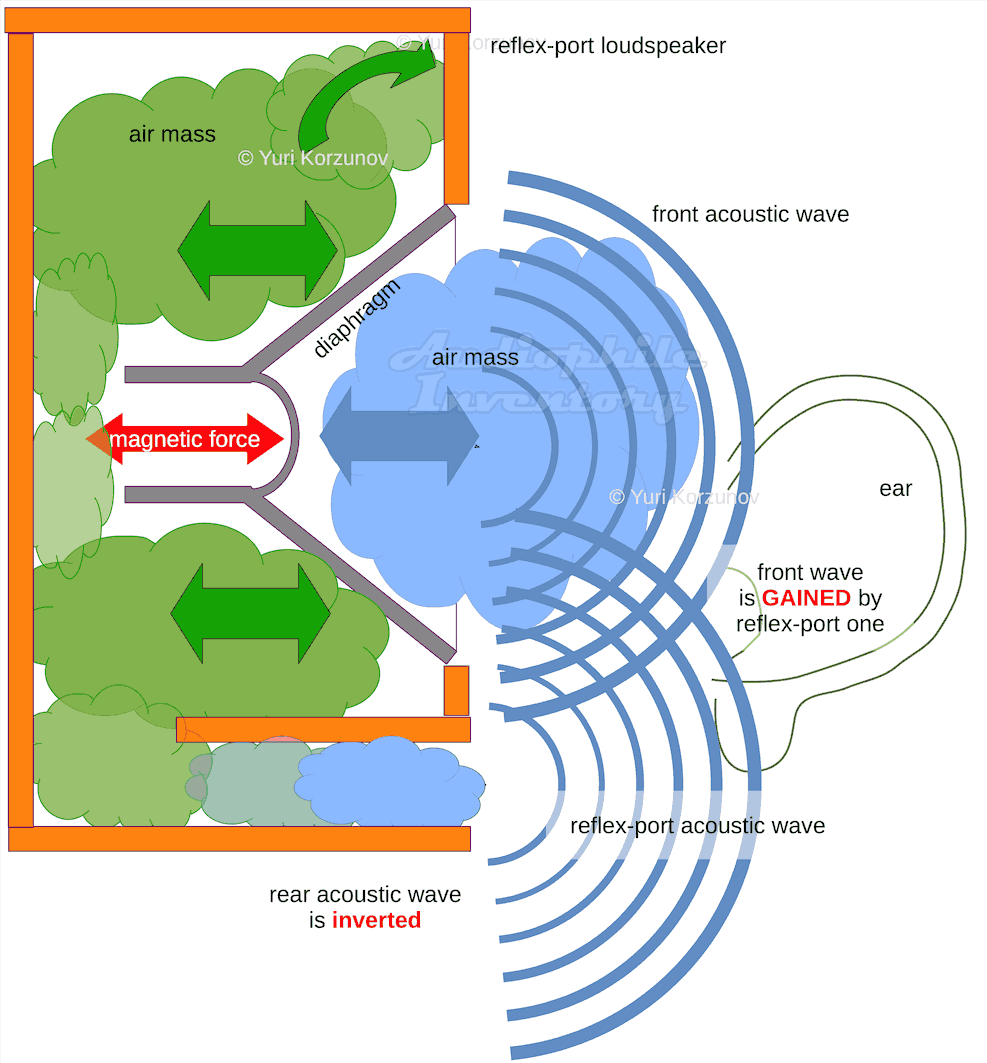
A reflex port of the speaker allows the phase inverting of a rear acoustic wave of the diaphragm to the same phase with the front wave from the driver. It allows the level gaining of air pressure.
A disadvantage of a reflex port is a significant dependency on frequency.
Back to top
Diaphragm rigidity
The absolutely rigid diaphragm doesn't exist. But, if the diaphragm is not absolutely rigid, not all parts of its surface move together.
It happens, because the force isn't thrown onto all points of the diaphragm surface.
When the center of the diaphragm begins to move, the edges of the cone still stay immovable. It causes surface deformation. Deformation moves from center to edges, together with the movement of the diaphragm center.
Example:
Two peoples hold both ends of one long wire. One human begins rock his hand up and down, and wave move from this person to another end of the wire. And the wire is twisted in the vertical plane.
Same way mechanical oscillation (surface twisting) from the center of the driver dome moves to its external borders.
And each of the parts radiates individual acoustic waves with a biased phase. Interference (summarizing) of these waves causes level altering, which depends on frequency. Because frequency defines wavelength in the air space.
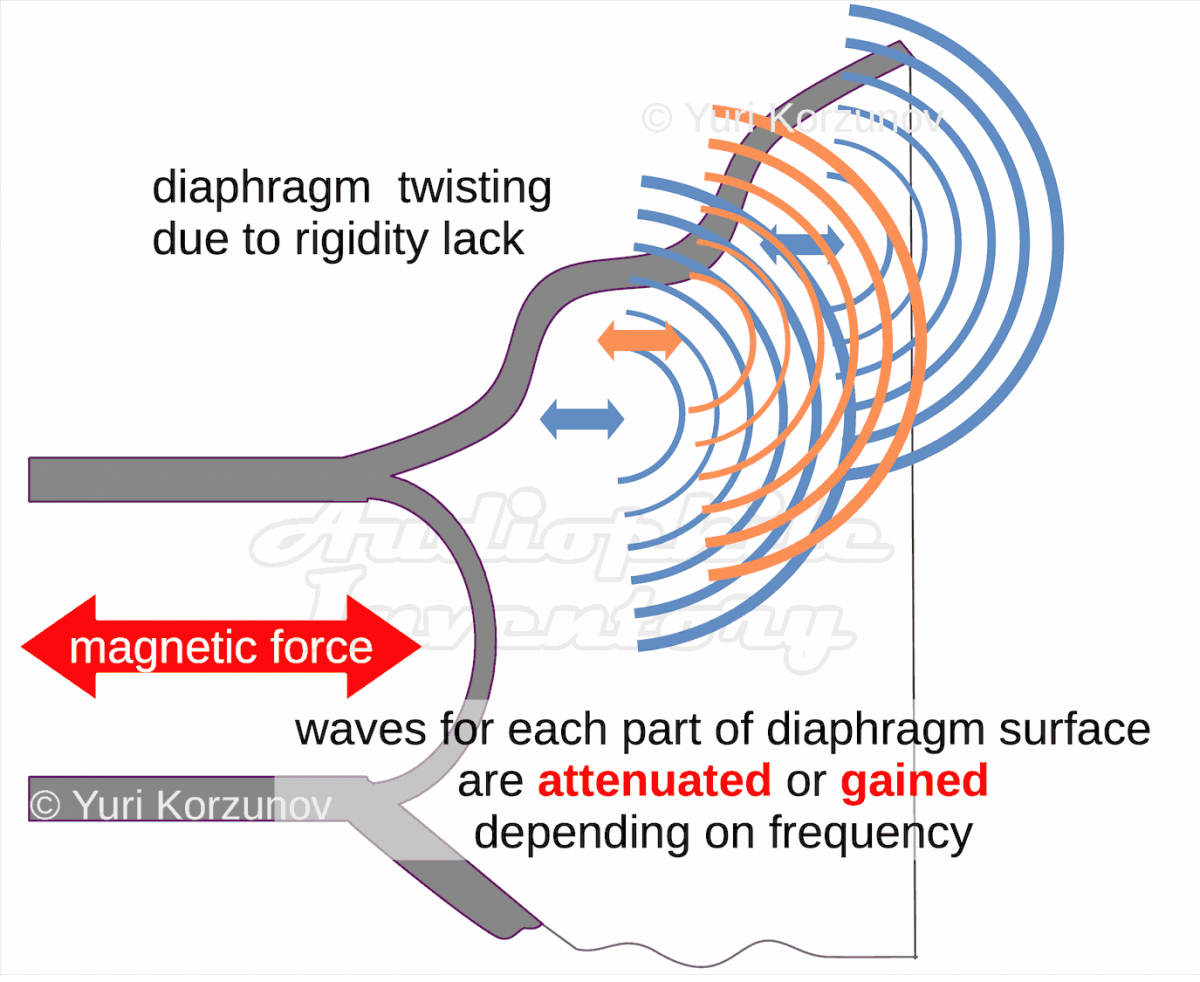
For an absolutely rigid diaphragm, all parts of its surface are moved simultaneously.
When we discussed back-to-front cancelation, we have seen, that a higher diameter of the loudspeaker reduces issues of the side-radiated acoustic wave by the diaphragm rear side. But we should understand, that higher diaphragm diameter reduces the rigidity of cone diaphragm in a voice-coil driver.
The rigidity issue may be solved via:
- diaphragm design (cone, dome, etc.);
- material (paper, kevlar, metal, etc.);
- size.
Example:
- the design manages rigidity by geometry;
- material define rigidity directly;
- size reduces the mechanical-twist value.
Back to top
Speaker crossover
A speaker crossover is a multiband frequency filter. It split the total signal to several frequency bands. One band per one loudspeaker driver (a group of drivers). Such feeding improves the dynamic range of each driver and allows to improve impedance fitting between a band amplifier and the driver.
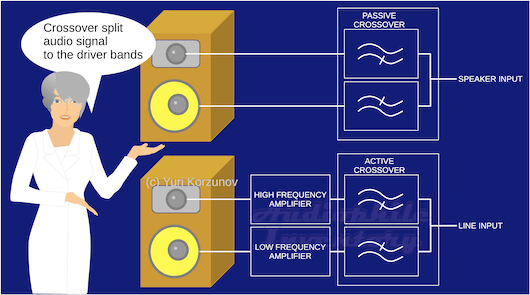
The splitting may be applied via active filters inside a loudspeaker with a line input (as variant, digital ones). It allows an improvement of the technical features of filters, comparing a passive crossover.
Sometimes, crossover and amplifiers may be implemented as standalone units outside the speaker (or several speakers: 1 per band). The connection may be applied via separate pins to each driver, which inside a single enclosure.
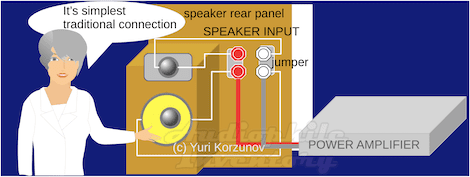
Back to top
Bi-amping
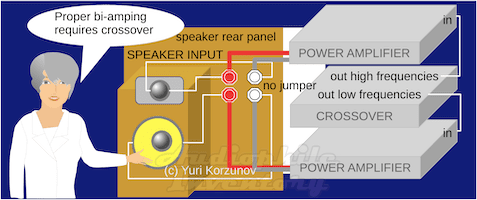
Sometimes, bi-amping is applied without the crossover. In this case, improvement is possible, when each of the amplifiers is better adjusted to the connected driver. But we get no dynamic-range advantages.
- An audio device (including a speaker) can receive a limited energy amount.
- Energy above the amount cause overload with harmonic distortions.
- If a crossover filters an ineffective (for a driver) frequency band, it frees the energy limit to use in the efficient frequency range.
- And we can use the driver at higher loudness with allowable distortions.
No mandatory advantages between the inner or outer amplifier connection. The result is depending on used units and their settings.
Back to top
Bi-wiring
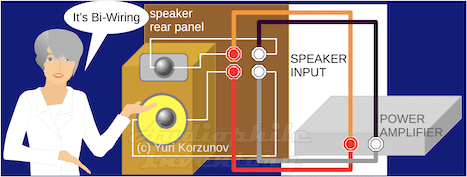
Bi-wiring has no clear explanation of its necessity.
However, bi-wiring may be implemented to reduce:
- the resistance of long cables, if no available thick cable;
- the skin-effect issues for too long cables (read details).
Large vs small loudspeakers
Larger diameter (square) of a driver diaphragm is capable to pump a more considerable volume of air mass in an environment.
Especially it's important in big rooms and open air.

Not any big head will well sound. And don't be tempted on big and, sometimes, cheap acoustics.
As example, big concert acoustics is not always a sound-quality leader. Concert acoustics is designed to provide greater sound pressure (on open air especially).
But requirements to its harmonic distortions may be fewer than for home hi-fi acoustics.
On-floor vs bookshelf speakers
If space on your floor is available, using the floor speakers may be preferable. It may happen due to the wider potential abilities of acoustical design (for manufacturers) in a bigger enclosure.
Note:
- no warranty, that an on-floor speaker is better than a bookshelf one;
- space should allow a direct way (without barriers) of a sound wave to your ears.
#sound-quality
So, if you don't have a place on the floor, use bookshelf speakers.
Loudspeaker sound quality
Back to topSound transparency
What is sound quality in technical terms? It's an only subjective sense of our ears?
We can measure quality.
Sound quality is minimum harmonic distortions and flat frequency response (as rule, lesser +/- 1 dB in a declared band).
Other measurement types may give a fuller description.
Usually, we apply the "transparency" term considering high frequencies (5-10 kHz). We qualify it as "air" or "airy sound".
What about low frequencies?
The same. But, we can't say "air" there. Bass notes should not be merged. No bass hum should not be there.
Also, psychoacoustical factors impact to actual relation between measurements and subjective perception.
Back to topWhat is harmonic distortion?
If sine signal feeds an input of a device, then generic sine with other sines (harmonics at other frequencies) is at the output. Other sines are called harmonic distortions. Its level is estimated.
Back to topAcoustic issues of a listening room
Bouncing of acoustic waves from walls, ceiling, floor, furniture and other surfaces may partially emulate a concert hall. It gives to us rear and side sound (like multichannel systems).
Into sound-insulated and anechoic room we feel discomfort. We listen to own bloodstream even. Such a room does not suit the audition.
The bouncing with wave interference, sound adsorption cause frequency distortions.
Mechanical resonances of room bring loudness boost at separate frequencies. Compensation may be applied via parametric equalizer or sound traps.
If waves summarize in the listening point with suppressing each other due to room acoustic properties, compensating with an equalizer may is not desirable. We should remember, that the waves may be summarized with boosting in other points of the room.
Read more...
Back to topWhat happens in a listening room
The sound (acoustic waves) from loudspeaker press to a human ear-drum. It's direct radiation or direct acoustic waves.
The reflections have a time delay relatively the direct wave.
Therefore, the cases are there:
- The direct and bounced waves push the ear-drum in the same phase. Loudness is higher than without bouncing.
- The direct and bounced waves push the ear-drum in the opposite phase. Loudness is lesser than without the bouncing.
- Intermediate variants.
These cases are different at:
- various points of a listening room and
- different frequencies.
It happens due to a wave has spatial length depending on frequency.
But, these cases are the same at different loudness levels.
How to eliminate these issues?
We can partially eliminate the reflections. But it can cause "dead" or "dry" sound.
More number of speakers can cause as increasing as decreasing of loudness (variously for different frequencies). I.e., multiple speakers can even worsen sound, theoretically.
Acoustic system tuning
Back to topMeasurements
A listening room with loudspeakers is a single acoustic system. Estimation is provided at the listener location.
To correct frequency distortions of the acoustic system, it is necessary to find frequencies of "resonances" and "dampings".
If you have measurement equipment, it's the simplest and fastest way to achieve a better result.
The simplest (but most expensive) method is a estimation via a panoramic SPL-meter. It should show a real-time spectrum (loudness along a frequency range) at a listening point.
Alternatively, you can:
- use simple SPL-meter to provide manual measurements at separate frequencies;
- own ears.
Test signals (hardware or software generator of sound frequencies):
- sweep sine,
- a sequence of frequencies.
Sweep signal isn't very good to detect frequency value by ears.
When we check the frequency sequence, resonances may be located between these frequencies.
Also, loudness memorization is an issue for ears.
Tips:
1. The author would recommend the records to test bass resonances:
- Cezaria Evora - album "Nha sentimento" - song "Vento de Sueste"
- Goran Bregovitch - album "New Collection" - songs "100 Lat Modej Parze", "Gas Gas"
- VA - album "Deep Bass. Low Frequency Sound Adventures" - song "Final Frontier"

2. What you can listen?
Bass notes must sound as separate notes with proper loudness (non-quiet, non-excessive), without muttering or buzz.
To control to high frequencies, you can use jazz and acoustic guitar records. Listen to sounds of cymbals and string scratches. These sounds should be clear, without "dirt". Recollect the live concert.
Acoustic treatment of a listening room
A listening room should be considered as part of an acoustic system. Always. No exceptions.
And the room is the first and most important part of sound-quality adjusting.
In general case, a listening room can't significantly improve (objectively or subjectively) the sound of acoustic systems. But the room can "kill" the sound.
Back to topPhysics of an acoustics
The acoustics is based on wave theory. In short:
- A loudspeaker driver is a wave source.
- Wave rays are distributed in a listening room, bounced and re-bounced from the room surfaces.
- The ray summation (interference) boost or suppress total acoustic oscillation.
- The wave sum at a point of the room depends on the wavelength.
- The room surfaces adsorb, reflect the rays.
- The rays are mathematical substances that show wave-spread directions.
So, we can change surfaces and the room (room-element) geometry to achieve desired wave distribution.
And we hear it.
We might model acoustic wave distribution in computer software. The project should be finally adjusted in a real treated room.
Back to topAims of acoustic treatment in various listening rooms
Recording studio
All sound management is applied inside audio recording and mixing equipment and software.
So, the room should absorb sound and provide acoustical isolation maximally.
Live performance or recording in a studio
Here conditions, that provide desired recorded sound, should be done. Sometimes, the record may not be edited or mixed before distribution.
So surfaces, acoustic design elements and its locations may be changed.
Live performance in a concert hall
The best sound (and/or loud) at a "sweet spot" of a concert hall should be provided, primarily. But, the rest places should have listening experience as better as possible.
Home listening room. Control studio room
The best sound should be provided at a "sweet spot" of the room primarily. Rest places, adjusted on request.
Back to topWays of an acoustic treatment
- Positioning of speakers in different place and distance from walls, ceil and floor.
- Different covers: temporary and permanent.
- Treating of room surfaces of special materials to adsorb / reflect / disperse / concentrate acoustic waves.
- Installing of objects with required acoustical properties (adsorb / reflect / disperse / concentrate) in different places of a treated room. The objects may be installed on the floor, ceiling, walls. Example: bass traps.
Tips:
- If your room contains a big glass or ceramic surfaces, it is not desirable for sound quality.
You can choose another room or cover these surfaces via acoustically adsorbing materials. Example: heavy curtains.
- You can add some "richness" to sound, using your listening room reflections.
It is not "correct" sound from a distortion point of view. But, subjectively, you can prefer such sound.

Back to top
Equalizers (EQ)
An equalizer is used to even frequency response, measured via SPL-meter or by hearing.
There are 2 types of equalizers:
- parametric and
- graphic.


Parametric equalizer provides better localization. An adjusted filter band causes minimal touching of "proper" frequencies.
Tips:
- Practically we can change the frequency of a test signal and look for peak-loudness frequencies (resonance). After it, we reduce the loudness at the resonance frequency via equalizer.
- A parametric equalizer can more precisely compensate a superfluous loudness at frequencies, than graphic EQ. Because parametric type is capable to set manipulation band to the problematic frequency ["Frequency" knob] and reduce gain there via ["Gain" knob].
- However, inter-suppressing of direct and reflected waves may not be compensated via EQ. Because it can cause excessive loudness in other room locations. But, an overload of electrical circuits is more expectable.
- Change of a speaker location, reflection management via acoustic treatment. Use sound-absorbing and sound dispersive materials for wall surface finishing. Install sound traps.
- You can calculate room acoustics via software. The final adjustment is practical.
Read more:
Back to top
Speaker cables
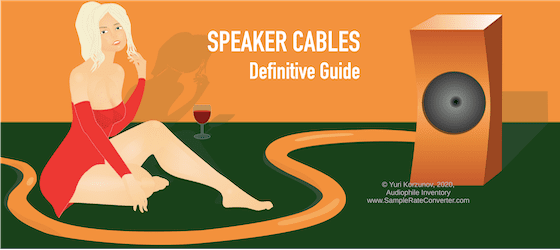
Speaker cables (acoustic cables) are cables to connect a loudspeaker to an amplifier.
Back to topA size of conductors
The size of wires in a low-frequency range (audio) is rather a matter of voltage losses.
These losses are more significant for:
- higher loudness;
- longer acoustic cables.
The diameter 1-3 millimeter(s) is optimal for most home applications when speakers are located close to an amplifier.
However, if the wires heats, you need to check:
- its diameter and
- work correctness of the amplifier.
Back to top
Skin effect
The skin effect is "pushing of AC (alternating current) from center to surface of a wire". The current concentrates closer to the outer surface of the wire.
This effect rises with the growth of frequency.
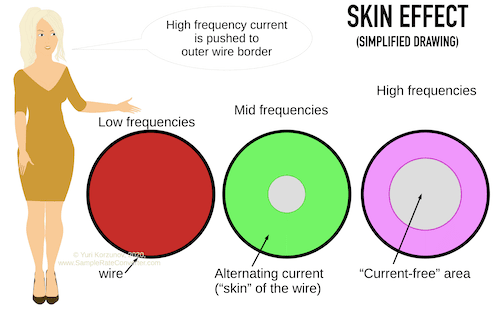
If refer to the table,
- when cables with 2 millimeter and below radius, this effect may rise above 10 kHz in a copper wire.
- for cables above 2.0 millimeters radius, it may happen below 10 kHz even.
What is the influence of the skin effect on an audio signal, that passed through the wire?
It is increasing of the voltage losses on the wire with frequency growth. The losses happen due to the rising of electrical resistance, which is a consequence of lesser wire size for AC at high frequency.
But, some details are there.
The skin-effect formula works for the infinite diameter of a cable. And, for small size wires (comparable with skin-layer thickness), the current distribution is more even (figure 8 / рис. 8 by this link).
There is no exact border of the skin-layer. The current smoothly increases from the outer border to the center.
I.e. thicker cables, despite lower resistance, are more influenced by skin effect, which impacts its resistance. But, the cable section is a circle. And skin-layer square distribution is not linear.
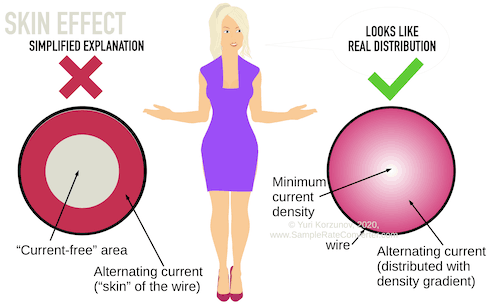
Table for conditions:
- copper cable with length 10 meters or lesser (from an amplifier to a speaker);
- 8 Ohm speaker.
| Attenuation at a frequency | ||
|---|---|---|
| Wire diameter (square) | 20 kHz | 50 kHz |
| 1.38 mm (1.5 mm2) | -0.043 dB | -0.086 dB |
| 3.2 mm (8 mm2) | -0.032 dB | -0.105 dB |
We can expect, that a human ear is sensitive to 1...2 dB loudness difference. But, even maximal (in the table) skin-effect attenuation (-0.1 dB) is significantly lesser.
Tips:
- To calculate the attenuation for a longer cable, sum attenuation.
Example: for 20 meter 3.2 mm cable [20 kHz]: - (0.043 + 0.043) = -0.086 dB
- Bi-, tri-, etc.-wiring of a thin (0.75 mm2) cables may be useful to reduce wire resistance and the skin effect for cables with length tens and thousands of meters (figure 8 / рис. 8 by this link).
Resume:
For copper cables with
- diameter 3 mm and lesser,
- speaker-amplifier distance 10 meters and lesser,
we can don't consider the skin effect.
Back to top
Conclusions
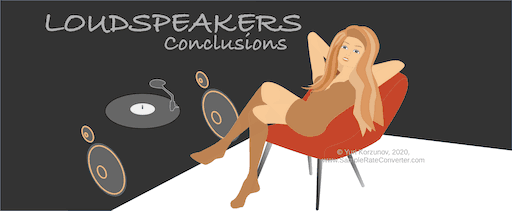
- If you look for high quality on a budget, check a sound "transparency" at mid and high loudness, primarily. But, if you agree to a higher price, check the "transparency" at the lowest loudness (in classical music, as example).
- A subwoofer is recommended for musical audio systems because it expands frequency range. But, such subwoofer should have low-level distortions.
- Mechanical treatment of a listening room is recommended as a primal measure of positive and negative resonance fixing.
- Equalization may be applied for room correction. But it is recommended rather for reducing resonances with higher loudness.
- In general, electrostatic speakers have advantages, but the issues are possible: low-frequency level; "sweet spot" size for high frequencies; air-humidity influence. Also, read the user manual with caution about electrical issues.
- In general case, acoustic cables don't big matter, when they are thick enough to provide allowable electrical resistance for a given distance. Personally, the author likes good acoustic and other cables due to aesthetic reasons. Also, for good acoustic cable, oxidation stability is desirable.
- The skin effect impacts cable resistance at high frequencies. The effect may be considered for very long cables (tens and hundreds of meters) for frequencies close to 20 kHz and above.
For thinner cables, skin effect doesn't work. But the cables cause higher resistance.
- Bi-wiring may have a sense for very long acoustic cables (tens or hundreds meters) to compensate for the skin effect at the frequencies of about 20 kHz.
- Bi-amping may have a sense for some combinations of amplifiers and loudspeaker drivers. But, a crossover is very desirable.
- A choice between a studio monitor and a home speaker is an individual taste matter rather.
- Adding of speakers to an existing system may as improve as degrade loudness and/or sound quality in a chosen listening point.
Frequently asked questions
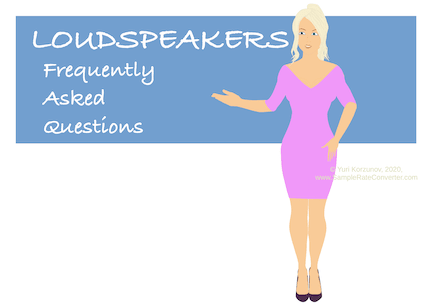
What is the difference between a speaker and a loudspeaker?
Speaker is a device that converts electrical oscillations to acoustical ones.
A loudspeaker is the same thing. Loudspeaker term may be used for devices to increase loudness primarily.
What is the function of a loudspeaker?
A loudspeaker (speaker) converts an electrical signal to acoustical waves.
What is the principle of loudspeaker?
Loudspeaker's work is based on several principles. Read more...
What are the uses of loudspeaker?
Loudspeaker is used to audio stuff (in instance, music) listening. Sometimes, speakers for outdoor loud work are called "loudspeakers". However, there is no standard.
Read more...
What are the 4 types of speakers?
Number of speaker types is more than two or four. Read about loudspeaker types...
What's woofer mean?
Woofer means speaker/driver to produce low notes (low frequencies). It's the biggest speaker that provides the lowest frequencies (bass) of sound. Subwoofer produces most low notes. In general case, woofer and subwoofer are the same or almost the same.
Read more...
What are a woofer and tweeter?
Woofer is a speaker driver to produce bass sound. Twitter produces high notes. Read more...
How can I make my speakers better quality?
Loudspeaker works with a listening room as a united system. You can electrically equalize frequency response of the loudspeaker, tune room surfaces and others.
Read details...
What is the difference between a subwoofer and loudspeaker?
A subwoofer is a loudspeaker, designed to reproduce of lowest frequencies. It may have a different destination in a movie and music.
Read more...
What are 3 ways speakers?
3 ways speakers consist of 3 drivers. Each of the drivers provides its own frequency band.
Read more...
What is a 4-way speaker?
4-ways speaker including 4 drivers: 2 twitters, mid-range, bass. Second twitter expands hi-frequency range of the speaker.
Read more...
Which loudspeaker is preferable: the vintage or the new?
Newer speakers use newer technologies. As expected, the technologies should tend to distortion reducing.
But, if you like vintage sound, you may prefer older loudspeakers. Also, vintage equipment may have its own good-looking design style.
That's individual taste matter only.
Which acoustical cables are the best for speakers?
In general, when long distance between loudspeaker and amplifier, more thick cable is preferable.
Sometimes the cables heat. And thicker cable reduces the temperature increasing.
Read more...
It is necessary to warm acoustic cables?
No. As rule, a practical temperature difference of the cable is not significant to impact the sound.
If the cable is too warm, try to use thicker cables and/or check correct work of the amplifier.
Read more...
Is music genre a matter for a speaker?
Some genres are demanded to distortion level. Other genres require louder sound.
If a loudspeaker is qualitative enough, a music genre does not matter. I.e. if your system is loud and perfectly plays classical music, heavy metal will be played successfully too.
Also, you can refer to your taste when estimating the "genre ability" of your speaker.
Read more...
Does a bi-wiring of speakers make a difference?
Don't expect a difference by bi-wiring. Especially for thick cables.
Read more...
What is better bi-wiring or bi-amping?
Technically, bi-amping allows us to better adjust a speaker driver to an amplifier. But it is not fairly for any combination of loudspeaker and amplifier. Also, qualitative crossover before amplifiers is a big matter of the final result.
Bi-amping may have a sense for too-long cables in some conditions.
Read more...
Do speaker cables make a difference in sound quality?
In general, the sound quality impact may be a matter of long cables and or thin (tens of meters and more).
Read more...
Can an electrical wire be used for speakers?
Yes. Except, if the wire oxidizes significantly over a short time. Generally, it's recommended to use acoustic cables.
Read more...
What happens if a speaker wire is too thin?
If a speaker wire is too thin, it can increase the impact of a long cable on the amplifier-speaker circuit. A more amplifier's power will be dissipated on the cable. Lesser power feeds the speaker. The wires heat more intensively.
Read more...
Can loudspeaker cable be too thick?
A too thick cable may be mechanically tough in connection. From point of view of sound qualuty, too thick cable does not matter.
Read more...
What is the skin effect for acoustic cables?
The skin effect is a high-frequency issue, that pushes a current to output border of a wire. It increases the cable resistance.
Read more...
What is the difference between a studio monitor and a speaker?
Studio monitors are designed to provide the full audible band maximally. It is desirable, that they give minimal distortions. It's closer to the "high fidelity" term.
But not all people like "monitor sound". It may be described as "boring", "dry", etc. Actually, this "sound" is very different, depending on monitor implementation. And vice versa, some home speakers may have a "lesser bright" sound than some monitors.
Studio monitors also may have design issues into an interior of a room of a home, because it is rather professional equipment.
So, the choice is an individual taste matter.
Read more...
Electrostatic vs electromagnetic loudspeaker. What's better?
| Electrostatic speaker | Voice-coil speaker | |
|---|---|---|
| Loudpeaker diaphragm rigidity (uneven frequency response) | may be better | |
| Sensitivity to environmental air humidity | better | |
| Loudness ability | may be solved via diaphragm size | may be better |
| Aperture of high frequencies ("sweet spot" size) | may be improved via curved diaphragm | may be better |
| Back-to-front cancelation | may be improved via size increasing | may be better |
| High-voltage hazard | protection is needed | lesser |
Can adding speakers improve sound quality and/or loudness?
It depends on:
- loudspeaker units (existing and adding);
- their placement;
- listening room;
- listening place.
Read more...
What are the advantages of loudspeaker?
Speaker is a multiple-listener tool.
It gives a more "natural" listening experience than it looks like with headphones.
Speaker impacts on the full human body. It may be important for low-frequency music content.
Audio Basis - articles about audio
Back to top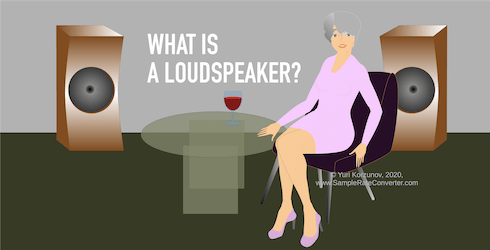
![How does a loudspeaker works [physics]](/sites/default/files/u1/loudspeakers/how-speaker-works-m.png)
